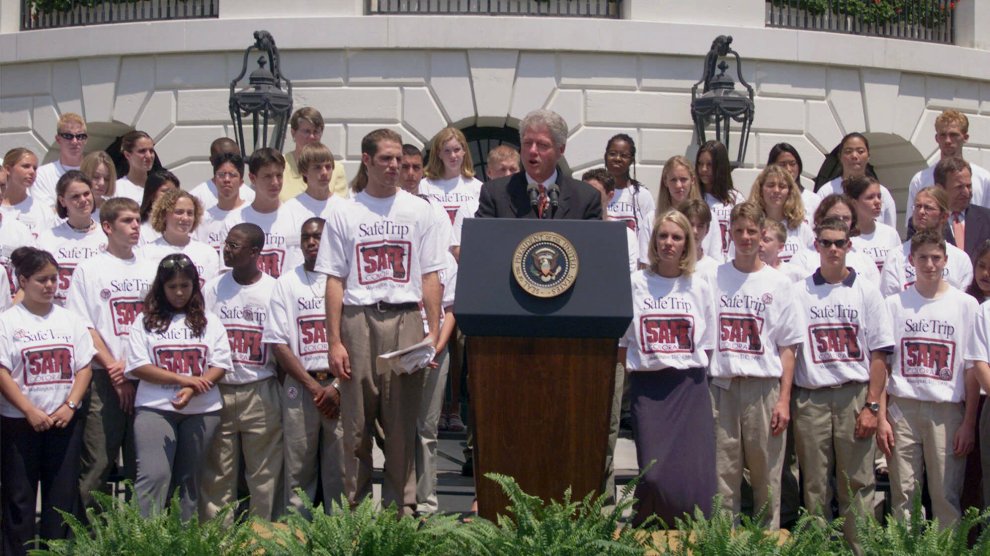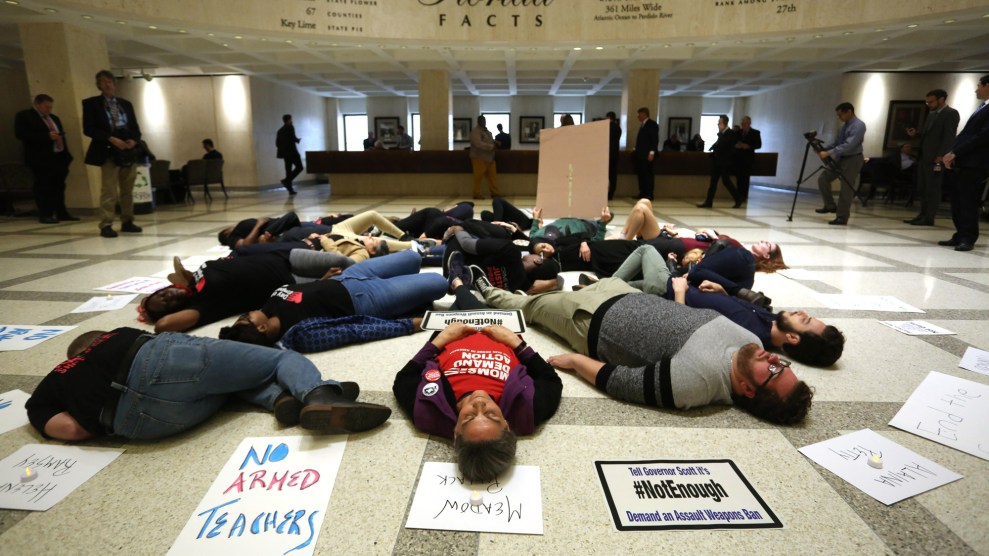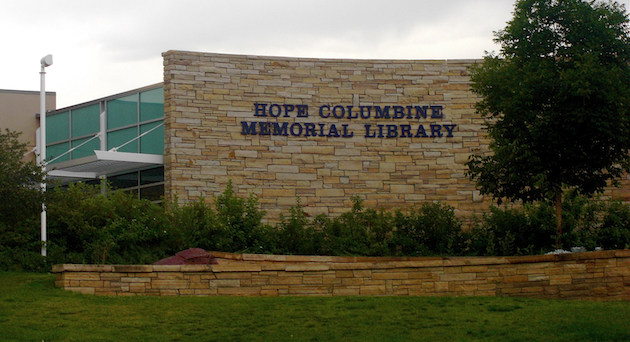
Members of SAFE Students with President Bill Clinton three months after the Columbine massacreSusan Walsh/AP
One day in April, two decades before the Parkland massacre, high school senior Ben Gelt was in philosophy class when he heard the news: Gunmen had burst into Columbine High School, just 15 miles away. Reports streamed in about explosive devices. Rumors spread about massive casualty counts. Gelt’s mind turned to the violence in the neighborhood near his own school, Denver’s East High. “I just remember thinking, ‘Jesus’—just being scared and not being sure about what could happen where I was.”
When he got home, Gelt’s mother, a member of the city council, mentioned that the National Rifle Association was scheduled to hold its convention in Denver less than two weeks later. “They shouldn’t come,” he told her. “Why don’t you cancel the contract?” She couldn’t do that. So Gelt, who was one of my high school classmates, set about organizing teenagers to protest the meeting. When school administrators wouldn’t let him spread the message during morning announcements, the Denver Post noted, he worked with other students to hand out fliers at area schools.
The students joined thousands of demonstrators at a rally organized by the Colorado Coalition Against Gun Violence, a gun reform group that had been launched a year earlier in response to school shootings in Paducah, Kentucky; Jonesboro, Arkansas; and Springfield, Oregon. They gathered at the state capitol, then marched to the nearby Adam’s Mark Hotel, where the NRA was meeting, and formed a human chain around the building. One of the protesters was Tom Mauser, whose son had been one of the 13 people murdered at Columbine. He carried a sign with a photo of his son and the words, “My son Daniel died at Columbine. He’d expect me to be here today.” He told the crowd, “If my son Daniel was not one of the victims, he would be here with me today.”
The protest made headlines around the world. “I am embarrassed that I was not involved in this earlier,” the father of a Columbine student who hadn’t been injured told the New York Times. ”It took something like this to wake me up, and I am ashamed of that.”
It was the start of a remarkable grassroots effort, in which survivors of the massacre, parents of the victims, and students from around the state banded together to demand tougher gun laws. The pre-social media campaign was nowhere near as large or as sudden as the nationwide student protests that sprang from last month’s shooting that left 17 people dead at Marjory Stoneman Douglas High School in Parkland, Florida. But the two movements share some striking parallels: high-profile TV appearances, frustrating negotiations with Republican lawmakers, and intense battles with the NRA.
A few weeks after the protest outside the 1999 NRA meeting, Mauser teamed up with a bipartisan group of gun control activists to launch Sane Alternatives to the Firearms Epidemic, or SAFE—an organization founded to promote “reasonable” gun regulations. At its kickoff event, Mauser criticized Colorado’s two Republican US senators for opposing legislation to fully close the so-called “gun-show loophole,” and for instead backing a watered-down measure supported by the NRA.
Under federal law, gun buyers can purchase weapons from private sellers without undergoing the background check that federally licensed dealers are required to perform. All four of the guns Eric Harris and Dylan Klebold used at Columbine were purchased from private sellers at gun shows. It’s impossible to know whether the massacre could have been averted if this loophole didn’t exist; Robyn Anderson, the student who helped the Columbine murderers buy three of the weapons, would have passed a background check if she’d been subjected to one. Still, she would later insist that she “wouldn’t have helped them buy the guns if I had faced a criminal background check.”
Background checks would become a major flashpoint in Colorado politics for the next year and a half. In his book Walking in Daniel’s Shoes, Mauser recounted leading a group of reporters to Sen. Ben Nighthorse Campbell’s office. “I carried the same sign I carried at the NRA protest a month earlier, but modified to say ‘Shame on Senators Campbell and [Wayne] Allard,’” he wrote.
Not long after, Gelt and one of his friends, David Winkler, who attended a nearby school in Denver, formed a youth-focused offshoot of the group called SAFE Students. In the days before Twitter and Snapchat, the pair did much of their organizing work from a phone in Winkler’s basement. They would cold-call national organizations and try to convince them to take the teenage activists seriously. “I called literally every gun control group in America and said, ‘We’re the SAFE Students, and we’re trying to organize young people to end gun violence and promote gun control. Can we work together?'” Gelt says.
The work paid off. In July 1999, Gelt and Winkler organized nearly 100 students, mostly from Colorado, to travel to Washington, DC. They lobbied lawmakers to close the gun-show loophole, ban high-capacity magazines, and prohibit anyone under the age of 21 from buying a gun—all fairly simple measures that gun control advocates are still asking for today in the wake of Parkland. It was a diverse group that included half a dozen Columbine students, as well as teens who’d experienced a very different type of gun violence in inner-city Denver. They met with President Bill Clinton and Vice President Al Gore; some of them appeared on news shows, such as Good Morning America.
At a press conference with high-ranking Democrats on the US Capitol steps, one Columbine student, who’d lost two friends in the massacre, said she didn’t want others to experience that kind of pain. “I do not want anyone else to have to lose a friend or loved one like I did,” she said, according to a transcript of the event.
Another Columbine student noted that other gun laws were being undermined by the lack of universal background checks. “Why have we created inconsistent rules for essentially the same transaction?” she asked. “This loophole makes it dangerously easy for a minor or a criminal to get a gun that otherwise would be illegal.”
Despite the media attention, the students “had trouble getting traction” with many lawmakers, says Diane Carman, a Denver Post columnist who traveled to Washington to cover the students’ trip. “A lot of people in Congress at that time really were dismissive of them,” Carman recalls. When Winkler attempted to talk to Georgia Republican Bob Barr about reforming gun laws, the congressman responded, “I would like you to write me a letter,” Carman reported at the time. Michigan Democrat John Dingell, who a month earlier had played a key role in derailing congressional attempts to close the gun-show loophole, told Winkler the same thing: “I’m busy. Write me a letter.” (Both Dingell and Barr served on the NRA’s board during their time in Congress.)
Back in Colorado, SAFE Students spawned chapters at schools around the state. At East High, where I was a year behind Gelt, many of my classmates joined the group, organizing meetings, raising money, and attending rallies. (I got involved, as well, though to a lesser extent.) Two of my friends purchased trigger locks—devices designed to keep kids from firing their parents’ guns—and attempted, with little success, to give them away outside a gun show.
When the Colorado legislature reconvened in January 2000, the SAFE activists turned their attention to changing state laws. With the backing of Bill Owens, the state’s moderate Republican governor, they pushed a slate of gun control measures—most notably, a bill to eliminate the gun-show loophole.
Supporters of the legislation brought in Anderson, who had attended Columbine with Klebold and Harris, to explain to lawmakers how she’d helped them purchase their weapons. “We spoke with several dealers, and the question was always, ‘Are you a private dealer or a licensed dealer?’” she testified. “A licensed dealer meant paperwork.” She added, “It was entirely too easy.” (There was no evidence Anderson knew of the shooters’ plans, and she was never charged with a crime.) It was a dramatic move, and it made some deeply uncomfortable. “I didn’t want to be in the same room with her,” wrote Mauser, who by then had been hired as SAFE’s full-time lobbyist. He ended up missing her testimony when he was invited by Clinton to attend the State of the Union address, where the president honored him.
After weeks of high-stakes lobbying, a GOP-controlled House committee defeated the background check legislation by a single vote—a setback Mauser attributes to pressure from the NRA.
But that was just the beginning. Gun control activists immediately launched an effort to place the gun show provision on the November 2000 ballot. Students gathered signatures. Carman reported that one Columbine student “worked hard for the passage of Amendment 22. Since she was too young to circulate petitions herself, her mother gathered signatures to get the measure on the ballot.” Mauser, the most visible proponent of the measure, campaigned tirelessly around the state, debating critics of the initiative and speaking to the media. And like the Parkland survivors, he quickly became the target of right-wing vitriol and even received a death threat.
The ballot initiative ultimately passed with 70 percent of the vote. The students were obviously only one piece of the campaign, but Carman believes they made a difference. “The students, and some of the parents, were important factors in keeping the pressure up,” she says.
In addition to the ballot measure, Mauser celebrated another triumph that night—the defeat of Debbie Allen, the Republican state legislator who had cast the tie-breaking vote to kill the loophole bill in committee. Mauser campaigned for her opponent, handing out fliers door-to-door. “We clearly targeted her,” he recalls.
Voters in Oregon also approved a measure to close the gun-show loophole that year, but these hard-won successes weren’t reflected in Washington. In the same election, George W. Bush, who benefited from millions of dollars in NRA campaign spending, captured the White House. Many Democrats, perhaps incorrectly, blamed the loss on the party’s embrace of gun control. Gun control advocates fought on, but Republican dominance in Washington sapped much of the momentum created in the late ’90s. “Nationally, very little came out of it,” Gelt laments. SAFE Students continued for a few years but received far less attention.
Nineteen years after Columbine, there’s still no federal law requiring background checks for private firearms sales. A bipartisan group of senators tried to close the loophole after the 2012 Newtown massacre. The NRA fiercely opposed their bill, and it was filibustered in the US Senate by Republicans and a handful of Democrats.
But with the stunning emergence of student protests after the Parkland massacre—a far larger and more sophisticated movement than anything that happened after Columbine—activists hope that this time could be different. Mauser, who still works on gun control issues with the group Colorado Ceasefire, says that while the involvement of students “really helped” after Columbine, it was “nowhere near like it is now.” Already, Parkland survivors and their allies have convinced Florida’s GOP-controlled legislature to adopt a host of modest firearms restrictions opposed by the NRA, including increasing the minimum age to purchase a gun to 21 and instituting three-day waiting periods. Activists are demanding that Congress finally act to strengthen background checks and outlaw assault rifles. And Saturday’s student-led March for Our Lives promises to draw massive crowds across the country.
A gentle reminder that all we are aiming for here is stricter gun laws that make it harder for people to get guns (because it shouldn't be easier than getting a drivers license) and the removal of Military Grade Weapons from Civilian Society. #BanAssaultRifles #GunContolNow
— Emma González (@Emma4Change) February 25, 2018
“I had given up completely on gun control for the last few years because I felt like it was hopeless,” says Carman, who still writes columns for the Post. “I think these early signs of success of these students from Parkland…[are] really exciting and encouraging.” The Parkland movement, she says, is “vastly different” from its predecessors, and not just because of the students’ proficiency with social media. “So many more students are aware of the threat now,” she says. “[They] feel personally much more vulnerable.”
All the @NRA wants is to sell you guns and EVERY politician that takes money from them wants to make it EASIER for you to buy them.
That’s why they introduce bills that don’t even mention guns OR background checks.
Not once. #THISISWHYWEMARCH
— Cameron Kasky (@cameron_kasky) March 19, 2018
Gelt has nothing but praise for today’s students. “Everything they are doing is great,” he says. “It’s powerful. It’s so incredible to look at.” When I asked if he had any advice for them, he recalled a warning Clinton had given the group when they visited Washington in 1999. Politicians would pay attention to students in the months after the tragedy, the president said, but many would abandon the issue as soon as the public stopped paying attention.
“We encountered these entrenched positions and very well funded groups and people that were willing to lie and willing to obfuscate and willing to pay lip service,” says Gelt. Opponents of gun control “were running down the clock,” knowing that the longer they could delay action after the shooting, the easier it would be to do nothing.
That’s a lesson that today’s teenage activists already seem to understand. One student organizer, Eve Glazier, recently told NPR that “she’s frustrated that in the past these school shootings happen, and a few weeks later the country seems to move on to the next big story with little or no policy changes.” Her solution: Hold another student protest, a month after Saturday’s march, to commemorate the 19th anniversary of Columbine.














